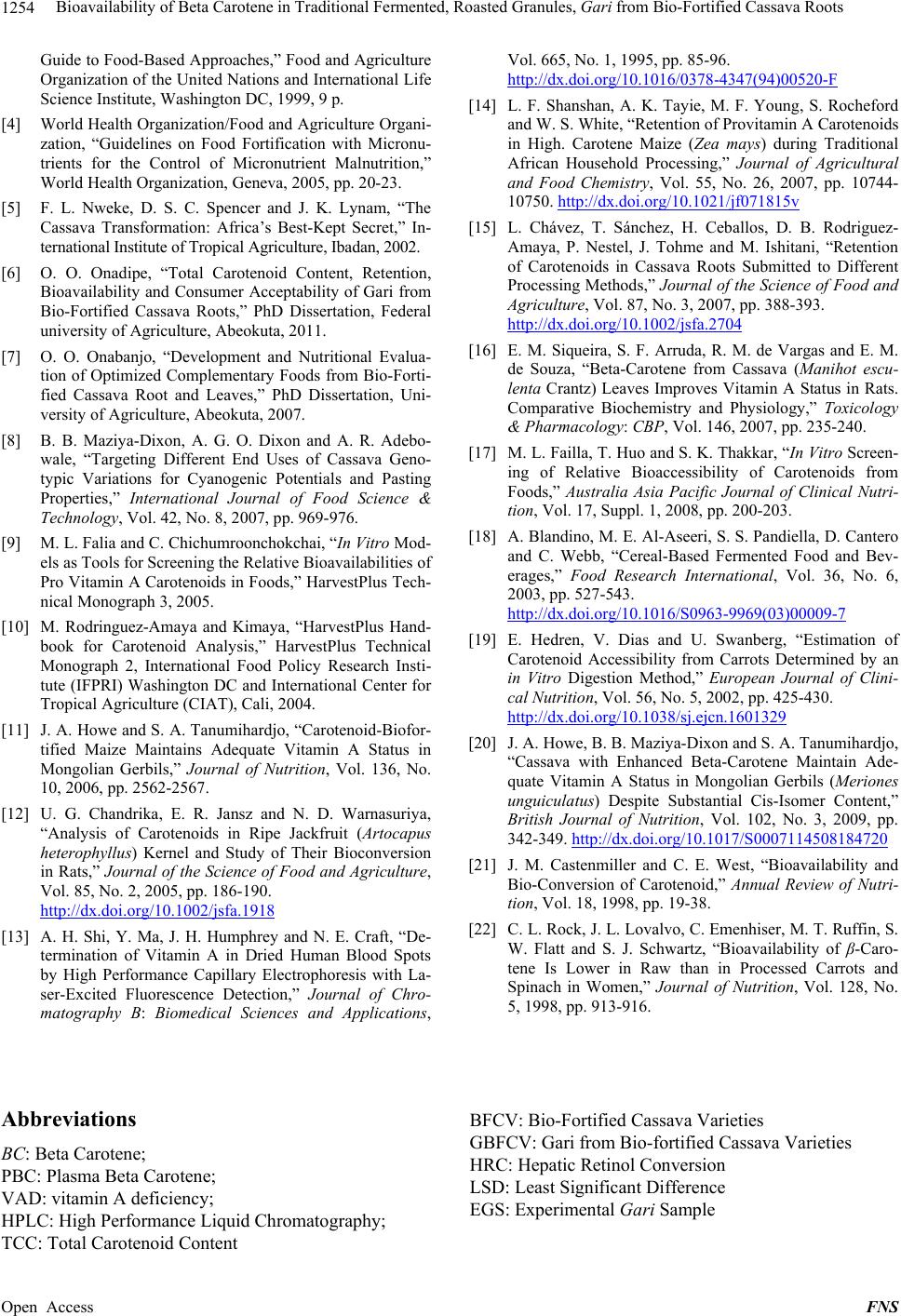
Bioavailability of Beta Carotene in Traditional Fermented, Roasted Granules, Gari from Bio-Fortified Cassava Roots
Open Access FNS
1254
Guide to Food-Based Approaches,” Food and Agriculture
Organization of the United Nations and International Life
Science Institute, Washington DC, 1999, 9 p.
[4] World Health Organization/Food and Agriculture Organi-
zation, “Guidelines on Food Fortification with Micronu-
trients for the Control of Micronutrient Malnutrition,”
World Health Organization, Geneva, 2005, pp. 20-23.
[5] F. L. Nweke, D. S. C. Spencer and J. K. Lynam, “The
Cassava Transformation: Africa’s Best-Kept Secret,” In-
ternational Institute of Tropical Agriculture, Ibadan, 2002.
[6] O. O. Onadipe, “Total Carotenoid Content, Retention,
Bioavailability and Consumer Acceptability of Gari from
Bio-Fortified Cassava Roots,” PhD Dissertation, Federal
university of Agriculture, Abeokuta, 2011.
[7] O. O. Onabanjo, “Development and Nutritional Evalua-
tion of Optimized Complementary Foods from Bio-Forti-
fied Cassava Root and Leaves,” PhD Dissertation, Uni-
versity of Agriculture, Abeokuta, 2007.
[8] B. B. Maziya-Dixon, A. G. O. Dixon and A. R. Adebo-
wale, “Targeting Different End Uses of Cassava Geno-
typic Variations for Cyanogenic Potentials and Pasting
Properties,” International Journal of Food Science &
Technology, Vol. 42, No. 8, 2007, pp. 969-976.
[9] M. L. Falia and C. Chichumroonchokchai, “In Vitro Mod-
els as Tools for Screening the Relative Bioavailabilities of
Pro Vitamin A Carotenoids in Foods,” HarvestPlus Tech-
nical Monograph 3, 2005.
[10] M. Rodringuez-Amaya and Kimaya, “HarvestPlus Hand-
book for Carotenoid Analysis,” HarvestPlus Technical
Monograph 2, International Food Policy Research Insti-
tute (IFPRI) Washington DC and International Center for
Tropical Agriculture (CIAT), Cali, 2004.
[11] J. A. Howe and S. A. Tanumihardjo, “Carotenoid-Biofor-
tified Maize Maintains Adequate Vitamin A Status in
Mongolian Gerbils,” Journal of Nutrition, Vol. 136, No.
10, 2006, pp. 2562-2567.
[12] U. G. Chandrika, E. R. Jansz and N. D. Warnasuriya,
“Analysis of Carotenoids in Ripe Jackfruit (Artocapus
heterophyllus) Kernel and Study of Their Bioconversion
in Rats,” Journal of the Science of Food and Agriculture,
Vol. 85, No. 2, 2005, pp. 186-190.
http://dx.doi.org/10.1002/jsfa.1918
[13] A. H. Shi, Y. Ma, J. H. Humphrey and N. E. Craft, “De-
termination of Vitamin A in Dried Human Blood Spots
by High Performance Capillary Electrophoresis with La-
ser-Excited Fluorescence Detection,” Journal of Chro-
matography B: Biomedical Sciences and Applications,
Vol. 665, No. 1, 1995, pp. 85-96.
http://dx.doi.org/10.1016/0378-4347(94)00520-F
[14] L. F. Shanshan, A. K. Tayie, M. F. Young, S. Rocheford
and W. S. White, “Retention of Provitamin A Carotenoids
in High. Carotene Maize (Zea mays) during Traditional
African Household Processing,” Journal of Agricultural
and Food Chemistry, Vol. 55, No. 26, 2007, pp. 10744-
10750. http://dx.doi.org/10.1021/jf071815v
[15] L. Chávez, T. Sánchez, H. Ceballos, D. B. Rodriguez-
Amaya, P. Nestel, J. Tohme and M. Ishitani, “Retention
of Carotenoids in Cassava Roots Submitted to Different
Processing Methods,” Journal of the Science of Food and
Agriculture, Vol. 87, No. 3, 2007, pp. 388-393.
http://dx.doi.org/10.1002/jsfa.2704
[16] E. M. Siqueira, S. F. Arruda, R. M. de Vargas and E. M.
de Souza, “Beta-Carotene from Cassava (Manihot escu-
lenta Crantz) Leaves Improves Vitamin A Status in Rats.
Comparative Biochemistry and Physiology,” Toxicology
& Pharmacology: CBP, Vol. 146, 2007, pp. 235-240.
[17] M. L. Failla, T. Huo and S. K. Thakkar, “In Vitro Screen-
ing of Relative Bioaccessibility of Carotenoids from
Foods,” Australia Asia Pacific Journal of Clinical Nutri-
tion, Vol. 17, Suppl. 1, 2008, pp. 200-203.
[18] A. Blandino, M. E. Al-Aseeri, S. S. Pandiella, D. Cantero
and C. Webb, “Cereal-Based Fermented Food and Bev-
erages,” Food Research International, Vol. 36, No. 6,
2003, pp. 527-543.
http://dx.doi.org/10.1016/S0963-9969(03)00009-7
[19] E. Hedren, V. Dias and U. Swanberg, “Estimation of
Carotenoid Accessibility from Carrots Determined by an
in Vitro Digestion Method,” European Journal of Clini-
cal Nutrition, Vol. 56, No. 5, 2002, pp. 425-430.
http://dx.doi.org/10.1038/sj.ejcn.1601329
[20] J. A. Howe, B. B. Maziya-Dixon and S. A. Tanumihardjo,
“Cassava with Enhanced Beta-Carotene Maintain Ade-
quate Vitamin A Status in Mongolian Gerbils (Meriones
unguiculatus) Despite Substantial Cis-Isomer Content,”
British Journal of Nutrition, Vol. 102, No. 3, 2009, pp.
342-349. http://dx.doi.org/10.1017/S0007114508184720
[21] J. M. Castenmiller and C. E. West, “Bioavailability and
Bio-Conversion of Carotenoid,” Annual Review of Nutri-
tion, Vol. 18, 1998, pp. 19-38.
[22] C. L. Rock, J. L. Lovalvo, C. Emenhiser, M. T. Ruffin, S.
W. Flatt and S. J. Schwartz, “Bioavailability of β-Caro-
tene Is Lower in Raw than in Processed Carrots and
Spinach in Women,” Journal of Nutrition, Vol. 128, No.
5, 1998, pp. 913-916.
Abbreviations
BC: Beta Carotene;
PBC: Plasma Beta Carotene;
VAD: vitamin A deficiency;
HPLC: High Performance Liquid Chromatography;
TCC: Total Carotenoid Content
BFCV: Bio-Fortified Cassava Varieties
GBFCV: Gari from Bio-fortified Cassava Varieties
HRC: Hepatic Retinol Conversion
LSD: Least Significant Difference
EGS: Experimental Gari Sample